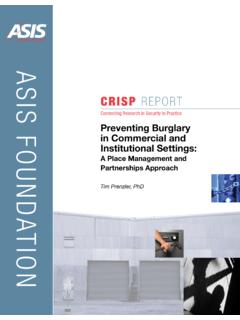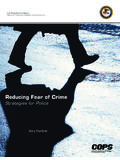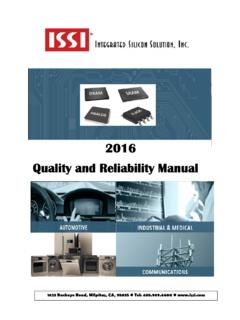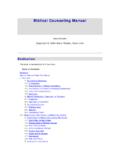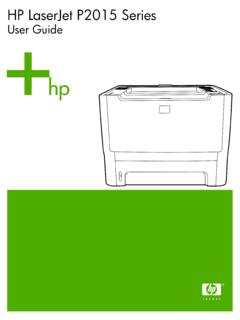Transcription of CAPRA Problem Solving Model Booklet - Center …
1 TO THE RCMP LEARNING MAPSCAPRAP roblem Solving ModelRoyal Canadian Gendarmerie royaleMounted Police du CanadaCanadaINTRODUCTIONThis is a learning tool designed to increase your understanding ofthe RCMP Community Policing Problem Solving Model , CAPRA . It isintended to promote discussion in small groups of employees, clientsand partners of the Royal Canadian Mounted Police. By following thediscussion points below, you can learn more about community polic-ing, and how its principles apply to how we work as an policing is defined by the RCMP as Problem Solving in part-nership with clients/communities to ensure continuous improvement inservice delivery. You can share thoughts and ideas with the membersof your group, and discuss how the RCMP can best work with com-munities to provide quality learning map is designed with open space to write down anyideas and suggestions.
2 (Erasable, black, dry markers or sticky notesare ideal for this purpose.) The discussion points below will help youunderstand how a Problem Solving approach could help you to betterresolve your work-related STARTED ^The images on this map are an extension of the ideas presented inThe Evolution of Policing in the RCMP map. The evolution map pro-vides an insight into the necessity for changes to police service is a Model for providing quality service, protection, enforce-ment and prevention, in partnership with clients/communities withintoday's Model emphasizes the importance of: developing and maintaining partnerships and trust withincommunities/the workforce to establish priorities for ser-vice delivery and preventive Problem Solving ; understanding our clients' perspectives on work-relatedmatters for establishing priorities and potential partnershipsin service delivery.
3 And encouraging ongoing feedback for continuous is a unique operational Model in that it provides an oppor-tunity for you to exercise any combination of service, protection,prevention and enforcement, whether a Problem exists or a potentialproblem can be prevented. CAPRA is more than a Problem solvingmodel. It is designed to assist the police officer or other members ofthe work force to anticipate problems and to prevent problems fromarising, where appropriate, in consultation with partners, as much asit is to resolve problems through multi-disciplinary, inter-agency andconsultative processes. It applies to enforcement as much as it does toprevention. It applies to every aspect of police internal organizationalservice delivery.
4 It is a method of service delivery that focuses on pro-viding the best quality service by reflecting an understanding of clients'needs, demands and expectations and, where possible, using partner-ship objective of this discussion/exercise, then, is to provide youwith practice in applying the Model to: identifying existing or potential problems and related issue; acquiring and analysing pertinent information; enlisting appropriate partners for the situation at hand; generating and selecting responses [options); and continuously improving service discussions are ideal for this purpose, because they give youthe opportunity to build on other people's ideas. You'll see howCAPRA applies to a variety of work environments that involve chal-lenges with: policy front-line work police management issuesFor today, read the narrative information out loud (represented bythe *J* symbol).]
5 The questions that follow are intended to stimulategroup discussions. On our own, we often come up with great ideas onhow to solve our own problems, but group discussion of these issueswill almost always result in a more manageable and effective anticipated responses have been listed to assist you in stimulat-ing discussion, if the facilitator, estimate how much time you might spend on eachsection of the diagram before you start the session. It's a good idea toleave some time at the end of the session for discussion of findings, anassessment of the session and next steps ( , how to use this newinformation).Before you start, remind group members that there are no right orwrong answers; some people may interpret the images and questionsdifferently, given their backgrounds and working should be encouraged when ONEC = Clients The left side of the diagram shows an open faced buildingin which a meeting is being conducted.
6 A consultative meetingis one method of getting to know your clients. There are differ-ent participants around the table, discussing and taking note ofthe issues that concern purpose of this meeting is to allow all participants to learnone another's point of view. It promotes a better understandingof what causes concern, for whom, and why. Through thisprocess, participants can clearly define and prioritize their prob-lems and concerns. The result is that proposed directions orsolutions will better address all participants' concerns and thusbe more likely to enlist their commitment to partnershipapproaches in this and future situations. Who are direct clients? Indirect clients?
7 Direct clients are people with whom you come into contacton a daily basis in service delivery or in Problem -solvingsituations and include individual citizens (suspects, victims,witnesses, concerned citizens, etc.) concerned citizengroups, internal clients (SEC, policy centres, regions, divi-sions, individual employees, etc.) and various agencies anddepartments. Indirect clients are people with whom you do not necessarilycome into direct contact, but who are affected by the out-come of your efforts. These indirect clients might includebusiness communities (where, for example, a series ofthefts have occurred); interest groups ( women'sgroups, where, for example, a sexual assault has occurred);cultural groups (where, for example, discriminatory prac-tices have occurred in the workplace); taxpayers (where, forexample, expenditures exceed value added).
8 What are some other ways of "getting to know" your clients? We should be continuously renewing our working relation-ships to ensure that the services we provide and the partnershipswe establish are helping to ensure safe homes and communitiesand a productive working environment. By establishing trustwithin clients/communities, we gain access to information,which is essential to preventing and resolving crime-related orinternal organizational problems. The better we know the capa-bilities of our partners, the more likely we are to quickly andeffectively address situations that example: How well do you actually know your clients? What are theirneeds, demands, expectations? What is the nature of your relationship with your clients?
9 Who is affected by the work that you do?* How do you suppose it would affect them?Getting to know your clients promotes efficiency. You knowwhat expectations you are facing, and can therefore more effec-tively address people's concerns. Such knowledge can also helpyou to more appropriately allocate resources. It gives you time todevelop appropriate plans and strategies from a well informedperspective. Your commitment to finding a mutually agreed solu-tion to a shared Problem will serve both you and your clientwell.*>SECTION TWOA = Acquire/Analyse Information The map provides examples of who to turn to for informa-tion -- people you work with, people who work in communitypolice offices, the town hall, a banking institution, a restaurant, aschool and citizens generally.
10 Information collected as part of acommunity profiling process, or a work orientation session willbe of value to you in future Problem - Solving situations. What is the importance of acquiring and analysing information? to fully understand what the Problem is, what the issues are,who is involved , where and when the situation occurredand how it might best be addressed - given your direct andindirect clients' perspectives; , to identify competing interests (needs, demands and expec-tations) ; to put yourself in the best position to manage the competinginterests in a manner that will ensure that al! participants feelthat the situation was handled fairly; to determine who your primary client should be, and to determine what your options are and what the best solu-tion might be.



